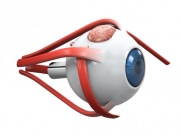Contents |
Convergence Insufficiency
Introduction
There are six muscles attached to each eye that control movement of the eyes in all directions. When these extra-ocular muscles are working in perfect harmony, it is comfortable and easy to perform visual tasks at any distance and at any direction of gaze. (Right: a diagram of the six muscles.)
Convergence may be thought of as the ability to cross the eyes; as funny as this may sound, we do need this ability every time we perform tasks like reading or using a computer. This is because when we are looking straight ahead and far away, the eyes should be in essentially parallel alignment; when the target gets closer, the eyes must turn inward to keep each of them aimed correctly right where it should be. Another name for inadequate convergence is exophoria. (Small amounts of exophoria are expected, especially for close vision, but when we cannot converge enough to maintain single vision, we can experience a variety of symptoms.)
However, we must also increase the focusing power to keep this single image clear; this is called accommodation. Ideally, when we are looking at an object in the distance, our eyes should not have to focus at all, and when that object comes closer, we automatically accommodate to maintain clarity.
To make our lives easier, these two systems are linked in the brain so that when we shift from distance to near, they each reinforce the other and keep the image both single and clear without either of them needing extra help in doing so.
Mismatching Systems
When our eyes focus correctly but don’t aim properly, we must add more convergence, but doing so also increases the amount of accommodation. When our eyes aim correctly but are out of focus we must add accommodation, but doing that also increases the amount of convergence.
This can be thought of as the feedback loop between the amount of convergence and accommodation being out of balance. The results can include eye fatigue, headaches, double vision, pulling sensations, poor reading skills and other symptoms of eye strain. In mild cases, it doesn’t usually cause a lot of problems, but when the imbalance increases, so does the visual stress. In more severe cases, where the brain can no longer overcome it, one eye may drift away from the target so we have episodes of double vision or even the type of strabismus called exotropia. Exotropia can involve the same eye being turned outward or alternate between the two; it can also occur only some of the time or be present constantly.
Parents should watch for several factors when their child reads:
- A tendency to hold reading material either too close or too far away
- Comments the child may make regarding “seeing two” of anything
- A tendency to turn the head when reading
- Using one hand to cover an eye when reading
- Avoiding reading or other similar activities
- Poor hand-to-eye coordination
- Excess blinking or eye watering
Additionally, they should make sure that the child has a well-lighted and comfortable place to read, and that the child isn’t using poor posture. Discourage reading while lying on the floor and if he or she wants to read in bed that they should sit up to do so. (This is because reading material is held too closely in these situations.) Frequent breaks to re-focus and relax are a good idea as well. Parents should also keep in mind that children don’t usually complain about their vision because they think everyone else’s vision is like theirs.
In practical terms, we should be able to converge our eyes to within only a few inches from our noses; this is not because we should hold things that close to us, (or to amuse our friends) but rather to have more ability than we actually need, so that even when the muscles begin to tire out we still have enough left to avoid double vision. If the eyes can only converge to 40 cm (about 16 inches), then we have none in reserve and begin to experience those symptoms of eyestrain again.
Treatment
Your eyecare practitioner will first want to discover if there is a refractive error present that is not currently corrected. Sometimes just correcting undiagnosed near- or far-sightedness can reduce or even eliminate a mismatch between the convergence and accommodative systems and bring immediate relief of eyestrain symptoms.
It may be necessary, too, to add prism to the eyeglass prescription. Vision therapy (VT) exercises to strengthen the convergence system using a variety of techniques, can be very effective, especially for children. VT has the ultimate goal of improving binocular vision skills to make it easy to read or use a computer without fatigue
Successful Outcomes
Generally, VT is quite effective at reinforcing the ability of the extra-ocular muscles to perform as they should. In a perfect visual world, we should all be able to drive, read, use a computer, and play both indoor and outdoor games as long and as easily as we breathe. Unfortunately, sometimes we need a little help to make things easier.
Fortunately, lenses and prisms can help us in increasing the abilities we need for extended tasks that we so often need to perform in today’s busy world.
See an eyecare practitioner for a comprehensive vision examination if either you or your child doesn’t seem to use your eyes efficiently, because we should all have the opportunity to see well and without undue fatigue.







